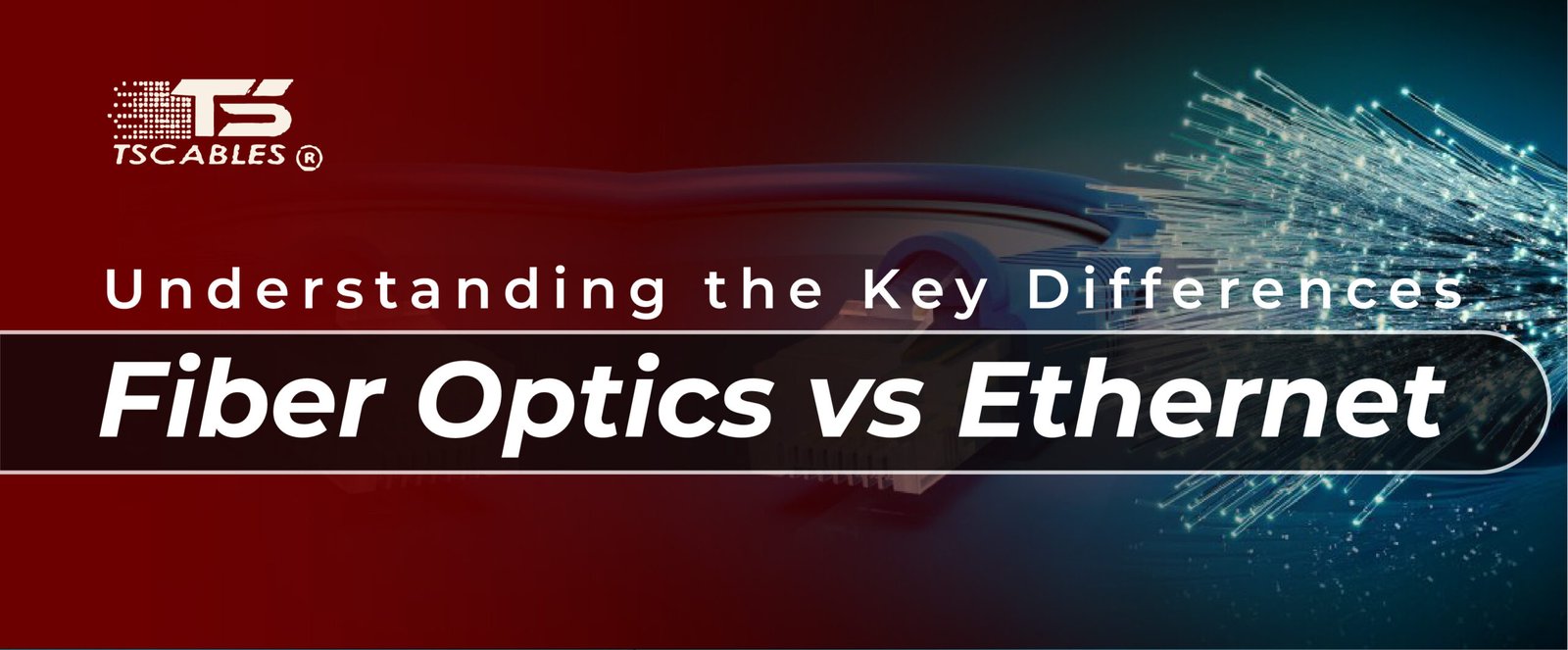- FREE 2 day shipping to all U.S. Mainland

When setting up a network, one of the big questions that come up is whether to use fiber optics or Ethernet. These two technologies are the backbone of many communication systems, but they serve different purposes.
Choosing between them depends on what you need from your network. In this article, we’ll break down the key differences between fiber optics and Ethernet, helping you understand when to use each one.
Fiber optic technology is based on the transmission of data using light pulses through thin strands of glass or plastic. These strands are called fiber optic cables and are designed to carry massive amounts of data over long distances.
The secret behind their speed and efficiency lies in the way they transmit information using light, unlike coaxial cables or copper cables that use electrical signals. A fiber optic internet cable can carry signals over miles without losing quality, making it a favorite for large networks, companies, and even cities.
Fiber optics also have much higher bandwidth, meaning they can handle more data at once. In recent years, fiber optic networking has become more accessible, allowing residential customers to enjoy blazing-fast speeds at home.
There are different Fiber Optics (FO) cable types, including single-mode and multi-mode. Single-mode cables are typically used for longer distances, while multi-mode is used for shorter distances. Both types offer higher performance than traditional Ethernet connections.
Ethernet is one of the oldest and most widely used networking technologies. It’s commonly found in homes, schools, and businesses. Ethernet uses electrical signals to transmit data over copper cables. The most popular type of Ethernet cable is Cat6, which is great for shorter distances.
Ethernet (also known as LAN cables) can handle fast internet speeds, but it can’t compete with the distance and bandwidth capabilities of fiber optics.
With Ethernet, there are also different categories of cables. The higher the category, the faster the speeds. For example, Cat6 vs. fiber comparisons often focus on how Cat6 is fast but limited by distance, while fiber shines in long-distance connections.
Ethernet still serves a critical role in everyday use, especially where long-distance data transfer isn’t a concern. For example, a fiber-to-RJ45 converter allows you to switch between fiber and Ethernet when needed. This flexibility ensures you can mix and match based on your requirements. Here are the primary differences between Ethernet and fiber optics:
If you’re asking yourself, “Which network type uses light pulses to transmit data?” then the answer is fiber optics. They rely on light pulses to send information quickly and efficiently, unlike Ethernet, which uses electrical signals.
Fiber Optic is ideal for large networks, long distances, and high data volumes (e.g., data centers, and cities). Its advantages include high speeds, low signal loss, and immunity to interference. However, there are some considerations such as higher cost, and requirement for specialized equipment.
Ethernet on the other hand is ideal for small networks, short distances, and basic internet needs (e.g., homes, small offices). It is affordable, easy to install, and compatible with various devices. However, slower speeds over long distances and susceptibly to interference are something you need to consider.
It depends on what you’re looking for. Fiber optics are unmatched for long distances, high speeds, and bandwidth. However, Ethernet is often sufficient for smaller networks, and it’s easier and cheaper to install. If you’re comparing FC vs. Ethernet, fiber is often superior for industrial-scale data centers, while Ethernet is typically enough for regular use.
Some factors to consider include speed needs, budget, and the physical size of the network. For businesses handling large-scale data, fiber optic cables are usually the better choice. For smaller homes or offices, Ethernet may do the trick without costing an arm and a leg.
A fiber optic cable is a type of cable that transmits data using light signals through glass or plastic strands.
Fiber loop refers to a ring-like connection often used in large networks to ensure continuous data flow. On the other hand, fiber optics is the broader technology that uses light signals for data transmission.
The best ethernet cable for fiber optic internet is usually a high-category one like Cat6, which can handle the high speeds fiber offers.
Fiber vs. cable latency is a key difference. Fiber provides lower latency compared to cable, which typically uses copper and experiences delays.
For smaller buildings, Ethernet should work just fine. For larger setups, especially where distance is a factor, fiber may be necessary.
For long distances and high-speed needs, fiber optics are best. For shorter distances and regular usage, Ethernet often suffices.
Whether you go with Ethernet or fiber optics depends on what you need from your network. Both technologies offer valuable features, but fiber shines for large, high-speed setups, while Ethernet remains a reliable choice for smaller networks.
Keep in mind the specific needs of your home or business when deciding between fiber optic cable vs. coaxial or copper vs. fiber optic options. Once you decide which one to go for, you can simply check out the different options available from TS Cables and purchase the one that meets your needs.
Copyright © 2024 TS Cables – All Rights Reserved